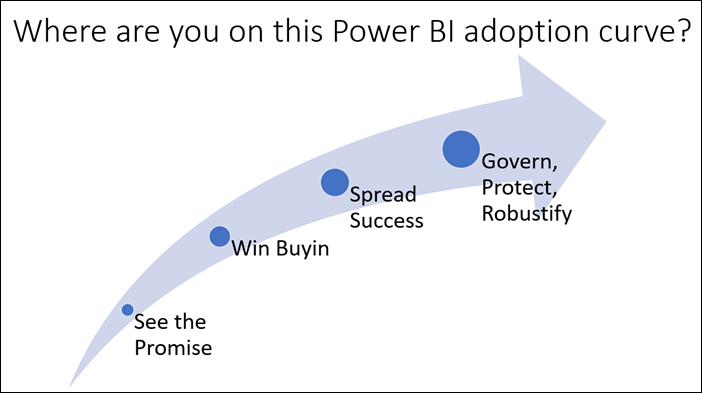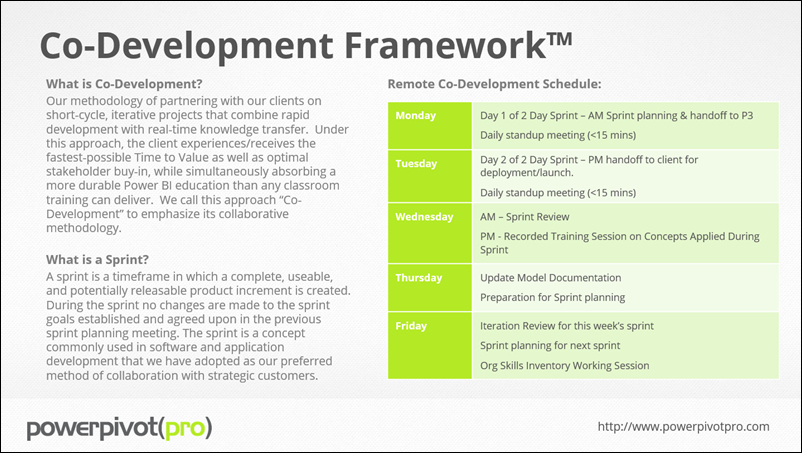
My 2010 Wake Up Call
Eight years ago, I lucked into an epiphany: IT-driven BI was going to give way to biz-driven BI (aka “self-service” or “Agile” BI). The new wave of BI tools – led by Power Pivot at the time, which ultimately grew into Power BI – gave business subject matter experts something they’d previously lacked: the ability to execute directly.
And while most people initially looked at Power BI’s bold forerunner as a “flash in the pan,” or at best as a way to cut some corners and save some costs, I’d witnessed something very surprising indeed: it WAS in fact less expensive in practice, but also much FASTER, and delivered much BETTER RESULTS than the traditional methodologies.
Faster, cheaper, AND better – the proverbial “free lunch.” And the BI industry, as we knew it in 2010, was gonna go bye bye. It was super clear, and a tremendous gift to be given a window into it that early on. So I’ve been building this company, in one form or another, for the better part of a decade.
I’ve also been “championing the cause” of Agile BI for all those years. And boy were the defenders of the traditional methodology a lot more stubborn in their doubts than I expected! At first it was upsetting to have people bristle at the idea of change, but over time I confess I kinda grew to relish it. It was kinda fun to be edgy. Revolutionary.
I spent so much time in that underdog stance, in fact, that I almost missed it when Agile BI went mainstream as an idea.
Moving from “If” to “How”
If you look around at what the industry’s analysts are saying today (and as always, I highly recommend Forrester’s Boris Evelson), you will see that Agile BI is in fact now taken for granted. The consensus is basically, “of course you have to embrace a biz-driven BI methodology if you want to keep up. Everyone knows that now.”
Obviously it’s super refreshing to live in a world where the experts are validating things I’ve been thinking for a long time. On the downside, I guess I’m gonna have to hang up the “edgy” schtick sooner or later. I’m gonna miss it.
But while the “head” of the industry is now wide awake to Agile BI, it’s clearly taking awhile for that signal to reach the trenches. Recent experience still indicates to me – strongly – that the world is still just beginning to change its ways. We need to switch gears in the discussion.
So today I’m here to say that from now on, when I write about Agile BI – and the implied importance of Power BI – I’m going to be talking about the How, as opposed to arguing with people who wonder about the If.
“OK then, let’s talk about How.”
First, I think it’s important to evaluate where your organization currently is on the adoption curve (and from here on, I’m going to be talking about Power BI specifically, even though most of the concepts would be the same if you were using a lesser tool heh heh).

Stages of Agile BI / Power BI Org-Wide Adoption
With the caveat that these naturally overlap and blend into each other quite a bit in practice, it’s helpful (in our experience) to identify four different stages of adoption:
1. See the Promise – at least one person in the org has to become convinced that Power BI is a gamechanger. Historically this happened in some hands-on, bottoms-up manner (someone tries it out and is blown away), but recently we’re seeing organizations buying Power BI in a top-down manner too – indicating that at minimum, someone important (often the CIO) has bought in.
2. Win Buyin – one person is, of course, never enough. So now you have to get others on board. This is obviously a challenge in bottoms-up examples of Stage 1, but it’s not exactly trivial in top-down situations either. The Business is suspicious of a message that sounds like “here’s a new data tool, you should use it instead of Excel,” particularly if it’s being advocated by IT.
3. Spread the Success– once you have a transformed a subset of your business into a Cult of the Converted, others are going to want in – and that’s the difference between stages 2 and 3. In stage 2, you were pushing adoption. In stage 3, others are pulling themselves into the game, and that’s what you want! But now you have a new challenge: the challenge of scaling. How do you empower all of your departments, even if they are enthusiastic about it?
4. Govern, Protect, Robustify– in later stages of your organizational change, this pretty quickly becomes your new “problem.” On one hand, biz-created Agile BI solutions are factually less chaotic than the spreadsheets they displaced. But their increased capability – in terms of data capacity, sophistication, and flexibility – does pose some new problems that spreadsheets didn’t. (Ex: at one of our clients we recently saw > 75 active Power BI gateways). I’d still argue, though, that the truly pressing need here is one of opportunity rather than “defense” – the Spreadsheet Jungle simply could not be governed, but Agile BI can. And there are tremendous benefits if you manage to find the “goldilocks” balance between freedom/agility on one hand – and responsibility/governance on the other.
Co-Development: a Term You Should Get to Know
I obviously don’t have space here to lay out everything we’ve learned over the years, but this one is perhaps The Thing. Over the years we found ourselves organically settling into the most-successful patterns of engagement, and “that thing where we sit down with you and just build what you need, together” kept floating to the top of the list. So we gave it a name: Co-Development. And once it had a name, it became easier for us to start codifying the details of it. Polishing and improving it.
In our experience, Co-development is a critical ingredient in stages 1-3 above, and can help make or break your Governance strategy by implication.

An Internal Slide We Use With Our Team
What Stage Are You In?
Do you recognize your org’s “location” within the four stages outlined above? We can connect you with Co-Development support that’s appropriate, whether you’re in stage one and kicking the tires, or in stage three and overwhelmed by demand. To fit those stages, as well as varying org sizes, we offer Team, Department, and Enterprise Co-Development plans.
After all, this isn’t just something we write about, it’s what we do for a living.
Let’s get started. Reach out to Brandon and Evan at sales@p3adaptive.com
Get in touch with a P3 team member